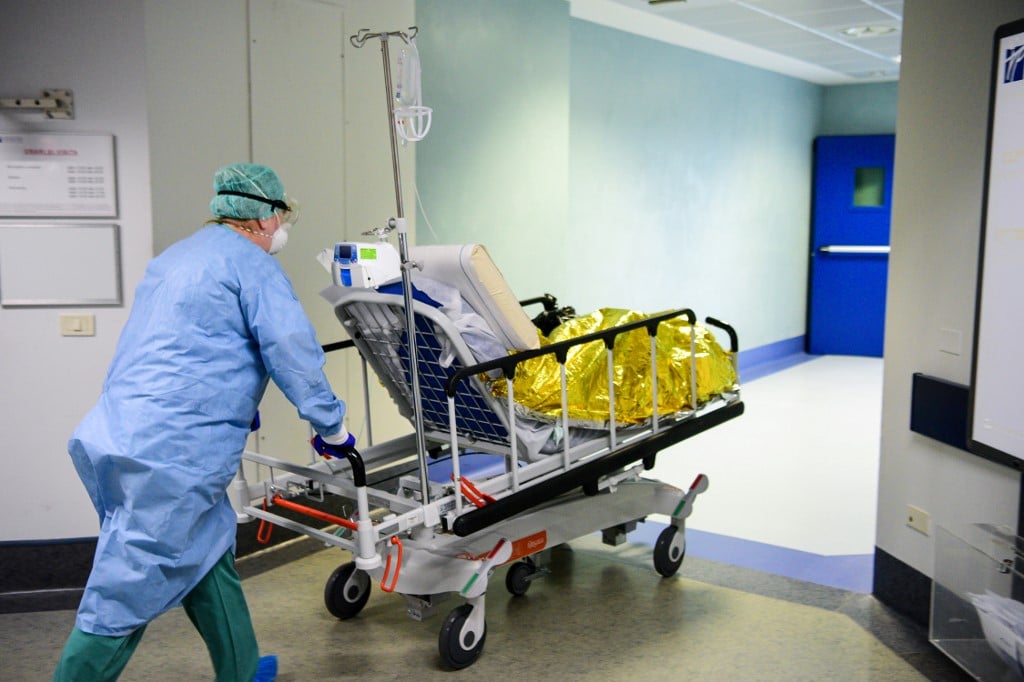ANALYSIS: When will the coronavirus epidemic in Italy peak?

The world is watching Italy to see when the number of deaths from COVID-19 and infections peak - and whether its nationwide coronavirus lockdown measures work.
But experts with the theoretical and medical background needed to make sense of these numbers are cautious about making forecasts.
Italian data, rising nationwide by hundreds of deaths and thousands of infections every day, vary depending on the region, and a whole range of different factors are at play.
Experts say that predictions are difficult -- and even useless if they look too far ahead.
March 23 to March 25
A team of infectious diseases and computer experts at the University of Genoa says it has a drawn up a model that predicts the evolution of COVID-19 "with an acceptable margin of error".
This model shows that in terms of new daily infections, the cases will peak between March 23-25.
What happens after that will depend largely on Italian government policies, and how Italians themselves behave.
READ ALSO: 'Stay at home': Italy's new coronavirus quarantine rules explained
Announcing an effective nationwide lockdown on March 11, Prime Minister Giuseppe Conte told Italians that the measures would take about two weeks to work.
The lockdown is due to expire on March 25, although schools and public institutions are set to remain closed until at least April 3.
"Reaching the peak doesn't mean you're in the clear," University of Genoa professor Giorgio Sestili cautioned.
"It only means that the epidemic has started to slow down and that - a few days later - you will have reached the saturation point of intensive care cases."
Sestili pointed that there will also be "imbalances" between Italy's 22 regions, with not every one reaching a peak at the same time.
 AFP
AFP
March 25 to April 15
Italy's National Research Council (CNR) expects a "significant reduction" in the growth rate of new infections in the Lombardy region around Milan by next Tuesday or Wednesday.
The northern region of around 10 million people has been at the epicentre of the crisis since the start, reporting two thirds of all the deaths in the nation of 60 million.
It has been under lockdown since March 8.
Noting that infections are starting to rise in the south, where many Italians moved to after the start of containment measures in the north, the CNR predicts that figures across Italy will only stabilise between March 25 and April 15.
"These estimates are subject to great uncertainty because various factors are at play, and must constantly be recalibrated according to the latest available data," CNR said in a statement.
It noted that people's behaviour changes, depending on what government measures are passed.
"It is very important to continue with containment measures, and to avoid the emergence of outbreak in central Italy and the south," Sestili told the Avvenire daily.
'Spots on a leopard'
Some simply scoff at the idea of making national forecasts, stressing that COVID-19 hit different regions at different times - and that some of the first containment measures were only imposed locally.
"Talking about a peak at a national level simply makes no sense," said Giovanni Rezza, who heads the infectious diseases department at Italian National Institute of Health (ISS).
"It is impossible to make forecasts because the epidemic is appearing like spots on a leopard," in places and not all at once, Rezza told Italian radio.
READ ALSO:
-
-
He said the worst was over in the province of Lodi, where the virus first appeared to the southeast of Milan, while in Brescia and Bergamo to Milan's east the situation was getting progressively worse.
Pierluigi Lopalco, an epidemiologist at the University of Pisa, was equally cautious.
"The forecasting models for COVID-19 are like weather forecasts," Lopalco said on Twitter.
"They are good for 24 hours, they are alright for the next 48 hours, but they are no longer reliable for the next 72 hours."
Comments
See Also
But experts with the theoretical and medical background needed to make sense of these numbers are cautious about making forecasts.
Italian data, rising nationwide by hundreds of deaths and thousands of infections every day, vary depending on the region, and a whole range of different factors are at play.
Experts say that predictions are difficult -- and even useless if they look too far ahead.
March 23 to March 25
A team of infectious diseases and computer experts at the University of Genoa says it has a drawn up a model that predicts the evolution of COVID-19 "with an acceptable margin of error".
This model shows that in terms of new daily infections, the cases will peak between March 23-25.
What happens after that will depend largely on Italian government policies, and how Italians themselves behave.
READ ALSO: 'Stay at home': Italy's new coronavirus quarantine rules explained
Announcing an effective nationwide lockdown on March 11, Prime Minister Giuseppe Conte told Italians that the measures would take about two weeks to work.
The lockdown is due to expire on March 25, although schools and public institutions are set to remain closed until at least April 3.
"Reaching the peak doesn't mean you're in the clear," University of Genoa professor Giorgio Sestili cautioned.
"It only means that the epidemic has started to slow down and that - a few days later - you will have reached the saturation point of intensive care cases."
Sestili pointed that there will also be "imbalances" between Italy's 22 regions, with not every one reaching a peak at the same time.
 AFP
AFP
March 25 to April 15
Italy's National Research Council (CNR) expects a "significant reduction" in the growth rate of new infections in the Lombardy region around Milan by next Tuesday or Wednesday.
The northern region of around 10 million people has been at the epicentre of the crisis since the start, reporting two thirds of all the deaths in the nation of 60 million.
It has been under lockdown since March 8.
Noting that infections are starting to rise in the south, where many Italians moved to after the start of containment measures in the north, the CNR predicts that figures across Italy will only stabilise between March 25 and April 15.
"These estimates are subject to great uncertainty because various factors are at play, and must constantly be recalibrated according to the latest available data," CNR said in a statement.
It noted that people's behaviour changes, depending on what government measures are passed.
"It is very important to continue with containment measures, and to avoid the emergence of outbreak in central Italy and the south," Sestili told the Avvenire daily.
'Spots on a leopard'
Some simply scoff at the idea of making national forecasts, stressing that COVID-19 hit different regions at different times - and that some of the first containment measures were only imposed locally.
"Talking about a peak at a national level simply makes no sense," said Giovanni Rezza, who heads the infectious diseases department at Italian National Institute of Health (ISS).
"It is impossible to make forecasts because the epidemic is appearing like spots on a leopard," in places and not all at once, Rezza told Italian radio.
READ ALSO:
He said the worst was over in the province of Lodi, where the virus first appeared to the southeast of Milan, while in Brescia and Bergamo to Milan's east the situation was getting progressively worse.
Pierluigi Lopalco, an epidemiologist at the University of Pisa, was equally cautious.
"The forecasting models for COVID-19 are like weather forecasts," Lopalco said on Twitter.
"They are good for 24 hours, they are alright for the next 48 hours, but they are no longer reliable for the next 72 hours."
Join the conversation in our comments section below. Share your own views and experience and if you have a question or suggestion for our journalists then email us at [email protected].
Please keep comments civil, constructive and on topic – and make sure to read our terms of use before getting involved.
Please log in here to leave a comment.